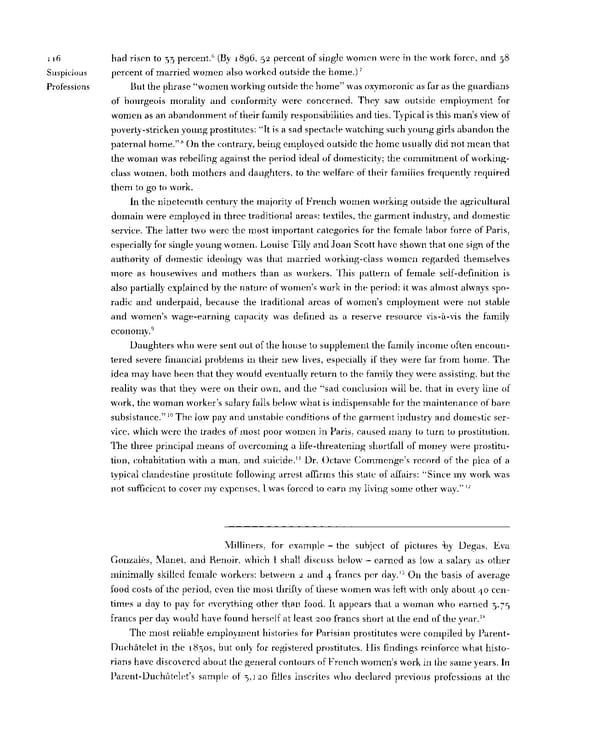116 had risen to 33 percent.6 (By 1896, 52 percent of single women were in the work force, and 38 Suspicious percent of married women also worked outside the home.)7 Professions But the phrase "women working outside the home" was oxymoronic as far as the guardians of bourgeois morality and conformity were concerned. They saw outside employment for women as an abandonment of their family responsibilities and ties. Typical is this man's view of poverty-stricken young prostitutes: "It is a sad spectacle watching such young girls abandon the 8 paternal home." On the contrary, being employed outside the home usually did not mean that the woman was rebelling against the period ideal of domesticity; the commitment of working- class women, both mothers and daughters, to the welfare of their families frequently required them to go to work. In the nineteenth century the majority of French women working outside the agricultural domain were employed in three traditional areas: textiles, the garment industry, and domestic service. The latter two were the most important categories for the female labor force of Paris, especially for single young women. Louise Tilly and Joan Scott have shown that one sign of the authority of domestic ideology was that married working-class women regarded themselves more as housewives and mothers than as workers. This pattern of female self-definition is also partially explained by the nature of women's work in the period: it was almost always spo- radic and underpaid, because the traditional areas of women's employment were not stable and women's wage-earning capacity was defined as a reserve resource vis-a-vis the family economy.9 Daughters who were sent out of the house to supplement the family income often encoun- tered severe financial problems in their new lives, especially if they were far from home. The idea may have been that they would eventually return to the family they were assisting, but the reality was that they were on their own, and the "sad conclusion will be, that in every line of work, the woman worker's salary falls below what is indispensable for the maintenance of bare subsistance."10 The low pay and unstable conditions of the garment industry and domestic ser- vice, which were the trades of most poor women in Paris, caused many to turn to prostitution. The three principal means of overcoming a life-threatening shortfall of money were prostitu- 11 tion, cohabitation with a man, and suicide. Dr. Octave Commenge's record of the plea of a typical clandestine prostitute following arrest affirms this state of affairs: "Since my work was 12 not sufficient to cover my expenses, I was forced to earn my living some other way." Milliners, for example — the subject of pictures ^by Degas, Eva Gonzales, Manet, and Renoir, which I shall discuss below - earned as low a salary as other 15 minimally skilled female workers: between 2 and 4 francs per day. On the basis of average food costs of the period, even the most thrifty of these women was left with only about 40 cen- times a day to pay for everything other than food. It appears that a woman who earned 3.75 14 francs per day would have found herself at least 200 francs short at the end of the year. The most reliable employment histories for Parisian prostitutes were compiled by Parent- Duchatelet in the 18308, but only for registered prostitutes. His findings reinforce what histo- rians have discovered about the general contours of French women's work in the same years. In Parent-Duchatelet's sample of 3,120 filles inscrites who declared previous professions at the
 Prostitution & Impressionists Page 136 Page 138
Prostitution & Impressionists Page 136 Page 138